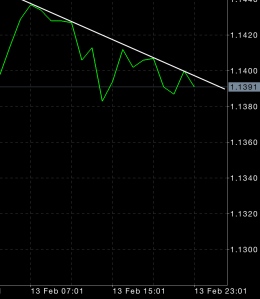GUIDED TRADING ACCOUNTS – SIMPLIFIED TRADING CONCEPTS – Lesson 2
If you haven’t read Lesson 1, please do before you read this one. Click here and we’ll take you to it.
Let’s do a practical example of what we’ve learned so far, based on the EUR/USD market on Friday, the day it was posted and sent to you.
Try to answer the question before looking at the next graph.
1- Can you identify the trend of that day? Upward or Downward?
The trend is Downward.
Now can you identify the C’s? Peaks or Dips?
The C’s in a downward trend are the Peaks
We’ve established UPs and DOWNs, and the pattern which, if you recall from lesson 1, is dictated by market volumes.
Let’s look at your Exit Strategy.
Knowing what you’ve learned so far, a trader would enter at the peak (point C), and hold until the downward trend ends, forms another dip, and then attempt an exit without loosing too much, as the market will normally move upward after the dip, while his trading position is Sell.
But those of you who tried it noticed that it’s not always that simple, is it? Sometimes you enter, and you hold, and then the trend changes suddenly on you, or “slides” like with arrow#1 in the figure below.
Or it takes forever moving one pip at a time, and watching it drives you crazy!
Let’s take a closer look at the EUR/USD movement of Friday, since those who read Lesson 1, have tried to apply it on that specific day:
The best case scenario would’ve been to:
C1: TRADE – SELL BY MARKET
1- 1437 – 1427 – went 10 pips down
2- 1427 – 1406 – went 21 pips down
C2 IS A “SLIDE” away from C1. Some wouldn’t recognize it, and most wouldn’t go in. Some traders would benefit from it by mistake, if they set their stop-loss at C1 to more than 10 pips.
3- 1406 – 1413 – went 7 pips up
C3: TRADE – SELL BY MARKET
4- 1413 – 1383 – went 30 pips down
5- 1383 – 1412 – went 29 pips up – this is a tricky one the downward dip between the 3rd and the 4th C’s. But by now you had the trend drawn, and you know it was not broken upward. 30 down, 29 up.
C4: TRADE – SELL BY MARKET
6- 1412 – 1402 – went 10 pips down
7- 1402 – 1407 – went 5 pips up
C5: TRADE – SELL BY MARKET
8- 1407 – 1387 – went 20 pips down
9- 1387 – 1400 – went 13 pips up
C6: TRADE – SELL BY MARKET
10– 1400 – 1391 – went 9 pips down
Notice that if, instead of opening a trade and watching until the pattern changes, you had simply put a Take-Profit at 10 pips down (you’re in as “sell by market”), and a Stop-Loss of 10 pips up, you would’ve won on all the trades. A total of 49 (or 59 pips if you recognized C2).
If you had set your T/P and S/L at 20 pips, then you would’ve won any 3 or 4 trades, so 49 – 59 pips. Same result, possibly less time invested.
Note that in both cases the market would’ve closed while your last trade hung at a profit of 9 pips, which you would’ve simply closed 5 minutes before closing. I’ve included these 9 pips in the above calculations.
This strategy has higher chances of working than not, because, as we’ve established in lesson 1, the patterns are forced by traded volumes of actual people constantly buying and selling.
Once you identify the entrance points (C’s), then you’re riding on a pattern where, hypothetically speaking, most traders wouldn’t switch before 10 pips.
I’m not saying this is a full-proof plan. Sometimes the market gets freakishly confusing. But to be fair I’ve used an actual day, and I’m just showing you why we believe that GTA casual traders should:
– trade smart (recognize the general trend of the day, the patterns and the C’s)
– and trade small, making small safe trades, so that every trading day may be as profitable as possible.
And for those of you who would like to stick to our original trading pattern: one or two trades per day, T/P & S/L 20pips. This blog is what we mean when we say that you can greatly tilt the odds in your favor. All you have to do is recognize one or two C’s, and you’re good to go.
We believe that casual traders do not have the time to watch the market all day. Beside the fact that it’s very frustrating to do so. And so we strongly believe in choosing a “C” point, setting S/L and T/P, and leaving the trade alone, eyes away, until it exits on its own. Then maybe one or two more, depending on the obviousness of the day trend, and the time that a casual trader has on their hands.
Now give the above a try, and if you have any questions, don’t hesitate to call your Financial Architect at Atlantis Financials, or send an email to services@atlantisfinancials.com.
We’d love some feedback from you about the above so that we make sure you’re benefiting from it.
Stay tuned for the next one!
Disclaimer: this blog was created to help beginner traders grasp some of the concepts of trading in a simplified way, inspired by other blogs or articles where traders have tried to do the same, and gathered here the way we saw useful to our clients. The concepts on this blog are in no way full-proof guaranteed successful trading or predictive methods, nor are they the only way one might trade successfully. Atlantis Financials and Charbel Khoury will not be held responsible for the results of the way the concepts in this blog are applied by readers and clients.







